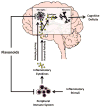Can consuming flavonoids restore old microglia to their youthful state?
- PMID: 21091915
- PMCID: PMC3058829
- DOI: 10.1111/j.1753-4887.2010.00336.x
Can consuming flavonoids restore old microglia to their youthful state?
Abstract
Microglial cells, which are resident macrophages in the central nervous system, are "primed" in the aged brain and are hypersensitive to messages emerging from immune-to-brain signaling pathways. Thus, in elderly individuals who have an infection, microglia overreact to signals from the peripheral immune system and produce excessive levels of cytokines, causing behavioral pathology including serious deficits in cognition. Importantly, recent studies indicate dietary flavonoids have anti-inflammatory properties and are capable of mitigating microglial cells in the brains of aged mice. Thus, dietary or supplemental flavonoids and other bioactive agents have the potential to restore the population of microglial cells in the elderly brain to its youthful state. This review briefly describes the immune-to-brain signaling pathways, consequences of microglial cell priming, and the potential of flavonoids to mitigate brain microglia and cognitive deficits induced by inflammatory cytokines.
© 2010 International Life Sciences Institute.
Conflict of interest statement
Figures


References
-
- Combrinck MI, Perry VH, Cunningham C. Peripheral infection evokes exaggerated sickness behaviour in pre-clinical murine prion disease. Neuroscience. 2002;112(1):7–11. - PubMed
-
- Perry VH, Cunningham C, Holmes C. Systemic infections and inflammation affect chronic neurodegeneration. Nat Rev Immunol. 2007 Feb;7(2):161–167. - PubMed
Publication types
MeSH terms
Substances
Grants and funding
LinkOut - more resources
Full Text Sources
Medical

